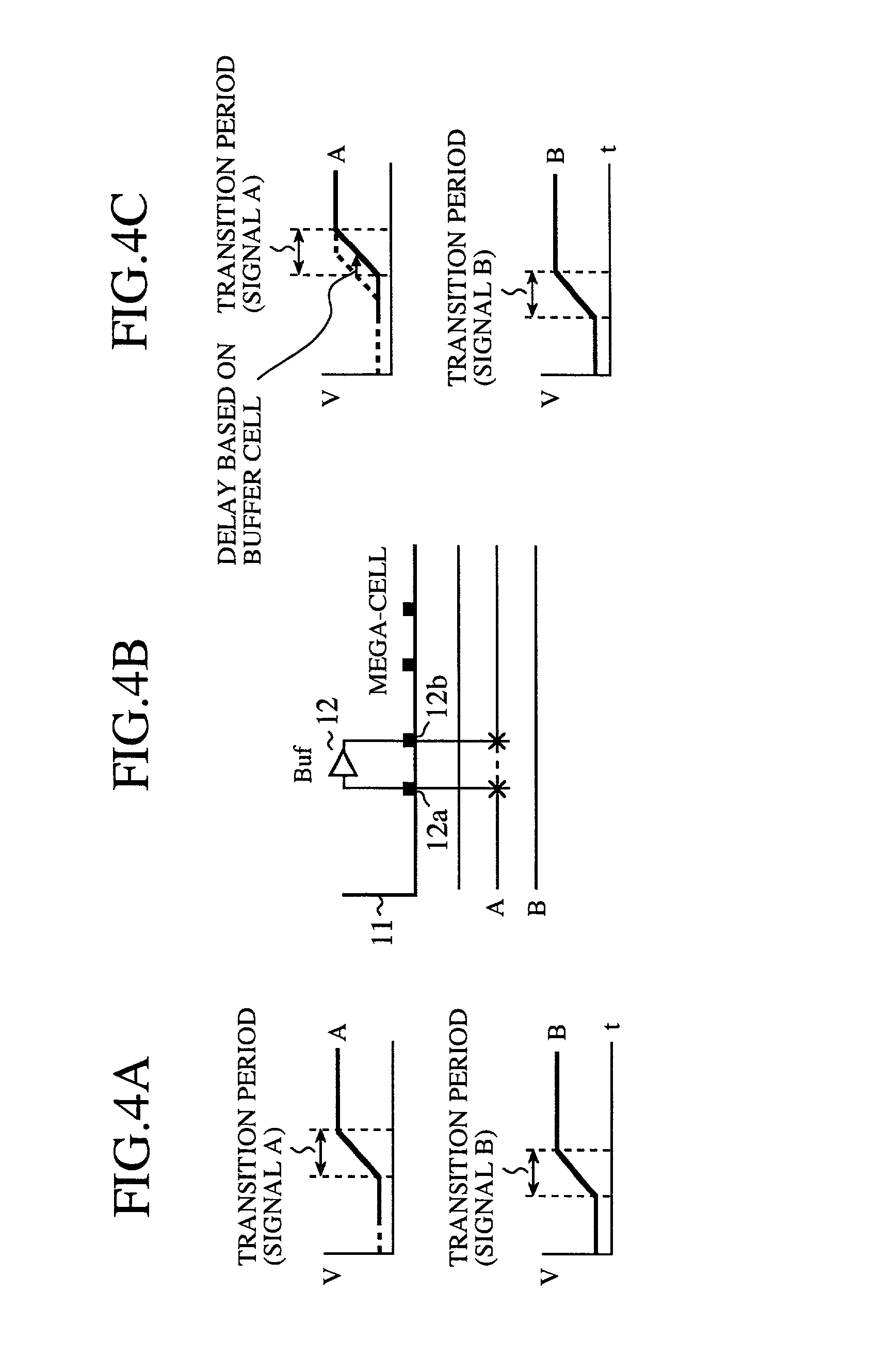Automatic cell placement and routing apparatus and automatic cell placement and routing method used for the apparatus
a cell placement and automatic technology, applied in the direction of instruments, cad circuit design, computer aided design, etc., can solve the problems of difficult widening of the interval crowded cell area, and inability to reduce the capacitance between the adjacent wires
- Summary
- Abstract
- Description
- Claims
- Application Information
AI Technical Summary
Benefits of technology
Problems solved by technology
Method used
Image
Examples
first embodiment
[0086] Therefore, in the first embodiment, when a layout of cells composing a semiconductor integrated circuit is designed by the cell placement designing unit 1 of the automatic cell placement and routing apparatus, as shown in FIG. 2A, the buffer cell 12 and / or the inverter cell 13 denoting the cross-talk improving cells are embedded in advance in an internal open space of each of mega-cells 11 and IO cells.
[0087] Thereafter, in the route designing unit 2 of the automatic cell placement and routing apparatus, when it is expected that a cross-talk noise is generated in a signal (or signals) transmitting through a wire (or wires) of the semiconductor integrated circuit, as shown in FIG. 2A, a mega-cell 11 (or an IO cell), which is placed in a position nearest to a generation position of the cross-talk noise, is selected from the mega-cells 11 and the IO cells. Thereafter, as shown in FIG. 2B, the buffer cell 12 and / or the inverter cell 13 embedded in the internal of the selected meg...
embodiment 2
[0089] EMBODIMENT 2
[0090] In the first embodiment, the buffer cell 12 and the inverter cell 13 embedded in the internal open space of the mega-cell 11 or the IO cell are inserted into wires in which signal error occurs because of the influence of the cross-talk noise. However, in general, a wire having a long wire length is liable to be influenced by the cross-talk noise. Therefore, in a second embodiment, as shown in FIG. 3A, one or more wires, which extend through the neighborhood of the mega-cell 11 or the IO cell, are selected from wires which respectively have a wire length equal to or longer than a prescribed value. Thereafter, as shown in FIG. 3B, the buffer cell 12 and the inverter cell 13 embedded in the internal open space of the mega-cell 11 or the IO cell are inserted into the selected wires to shorten the length of each selected wire.
[0091] Accordingly, the adverse influence of the cross-talk noise generated in the semiconductor integrated circuit can be reduced.
embodiment 3
[0092] EMBODIMENT 3
[0093] In the first embodiment, the buffer cell 12 and the inverter cell 13 embedded in the internal open space of the mega-cell 11 or the IO cell are inserted into wires in which signal error occurs because of the influence of the cross-talk noise. However, in a third embodiment, when a level transition period of a signal transmitting through a wire overlaps with that of a signal transmitting through another wire on condition that the wires are adjacent to each other, the cross-talk noise improving cell is inserted into one of the wires to make the level transition periods of the signals not overlap with each other.
[0094] In detail, in the route designing unit 2, level transition periods of signals A and B, which transmit through wires adjacent to each other, are calculated according to a dynamic or static timing analysis. In general, when level transition periods of signals transmitting through wires adjacent to each other overlap with each other, the signals ar...
PUM
 Login to View More
Login to View More Abstract
Description
Claims
Application Information
 Login to View More
Login to View More - R&D
- Intellectual Property
- Life Sciences
- Materials
- Tech Scout
- Unparalleled Data Quality
- Higher Quality Content
- 60% Fewer Hallucinations
Browse by: Latest US Patents, China's latest patents, Technical Efficacy Thesaurus, Application Domain, Technology Topic, Popular Technical Reports.
© 2025 PatSnap. All rights reserved.Legal|Privacy policy|Modern Slavery Act Transparency Statement|Sitemap|About US| Contact US: help@patsnap.com



